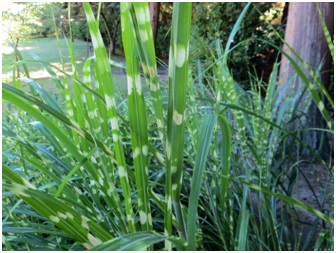Seven Flowers of Autumn
Seven Flowers of Autumn
aki no nanakusa
has been beloved in Japan for centuries. Photo: Aleks Monk.
The Seven Flowers of Autumn are all indigenous to Japan and have been loved by the Japanese at least since the Nara Period (710-794). They consist of Bush Clover hagi, Japanese Silver Grass susuki, Japanese Arrowroot kuzu, Pink nadeshiko, Valerian ominaeshi, Joe Pye Weed fujibakama, and Balloon Flower kikyo.
Perennials, like the seven flowers, are appreciated mainly for their flowers, so have never been core plant material in Japanese gardens that predominantly have green plant structures of trees and shrubs. However perennials are appreciated in their natural habitats in mountains and fields, and inspire poetry. The Azumaya is a perfect place to compose poems in the garden, and the adjacent bed is the perfect place to plant these inspiring flowers. Thus you will find four of the seven--Lespedeza, Miscanthus, Eupatorium and Platycodon--quietly blooming there during the early months of fall. These non-showy flowers are suitable for the atmosphere of the Japanese autumn, and the nearby orchard area is associated with the autumn season.
Numerous Japanese 31-syllable poems and haikus have been composed about the seven flowers. Many of them are in Manyoshu (the oldest Japanese poetry anthology edited in the Nara period). The two poems below are by Yamanoue-no-Okura (660-733. The poems are believed to be the origin of the tradition of the Seven Flowers of Autumn:
秋の野に 咲きたる花を 指(および)折り かき数ふれば 七種(ななくさ)の花
Flowers blossoming in autumn fields/When I count them on my fingers /then they number seven
萩の花 尾花葛花 なでしこの花 女郎花 また藤袴 朝顔の花
The flowers of hagi, obana, kuzu, nadeshiko, ominaeshi, also, fujibakama and asagao flower
From Left to Right: Bush clover, Japanese Silver Grass, and Joe Pye Weed planted in the Seattle Japanese Garden. Photos by Aleks Monk.
Lespedeza thunbergiiBush Clover 萩 hagi Lespedeza thunbergii is in the legume family and known by the common name Thunberg's Bushclover. It is native to China and Japan. Thunbergii refers to the 18th-century Swedish botanist Carl Peter Thunberg who visited Japan from 1775 to 1779.
It is considered the most beautiful Lespedeza with long clusters of flowers. Stems grow up to 7 feet tall. They die back completely at the end of the season. The abundant pink to purplish flowers bloom in late summer. The fruit is a legume pod containing black seeds but this species does not produce many seedpods. The Lespedeza in our garden is probably L. acutifolia.
Miscanthus sinensisEulalia/Japanese Silver Grass 芒 susuki The SJG has the cultivar ‘Strictus’ (Porcupine grass) that has bands of yellow across the leaves. Miscanthus sinensis is a species of flowering plant in the grass family, native to eastern Asia throughout most of China, Japan, Taiwan and Korea. It is an herbaceous perennial grass, growing to 3–7 feet tall, forming dense clumps from an underground rhizome. The flowers are purplish, held above the foliage. The Latin Miscanthus comes from the Greek for "stalk" and "flower" The qualifier sinensis means "from China", though the plant is found elsewhere in eastern Asia. Miscanthus stalks are cut and displayed for moon viewing events in autumn.
Eupatorium fortune Joe Pye Weed 藤袴 fujibakama The SJG has Eupatorium purpureum in the garden; it is native to the eastern U.S. It is three times larger in size (5 – 7 feet) than E. fortunei, which is native to China and Japan. It is clump-forming, with whorls of lance-shaped, finely toothed, sharp pointed, coarse, purple tinged, mid-green leaves. It bears terminal, domed, corymb-like panicles, 4-6 inches across, of pink, pinkish purple, or creamy-white flowerheads from midsummer to early autumn.
There are two versions of how the Joe Pye Weed got its name. The most common one traces it to a 18th Century Native American medicine man named Joe Pye, who traveled the length of New England treating fevers, typhoid fever in particular, with an infusion made from the plant’s leaves. The other story asserts that joe-pye is a corruption of the Native American word for typhoid, jopi.
The plant is used medicinally in both Japan and China. In traditional Chinese medicine it is indicated for poor appetite, nausea and vomiting due to 'dampness' obstructions or summer heat. Its modern usage includes treatment for stomach flus and acute gastritis.
From Left to Right: Balloon Flower, Pink, and the south bed of the Azumaya with four of the Seven Flowers of Autumn in bloom. Photos: Aleks Monk.
Platycodon grandiflorus Balloon Flower 桔梗 kikyo grandiflorus is a Genus of one species, native to east Asia. It is compact, clump-forming, with ovate to ovate-lance-shaped, toothed, bluish green leaves, to 2in long, borne in whorls on the lower stem, alternately higher up. In late summer, clusters of large, balloon-like buds open to shallow, bell-shaped, 5-petled, sometime double, purple-blue or white flowers, to 2in across, with darker blue veins and pointed tips to the petals. Grows to 24in high and 12in wide.
Kikyo flower designs are used for Japanese family crests.
Dianthus superbus Pink 撫子 nadeshiko The leaves are edible when young, and can be eaten when boiled. The flowers contain sweet nectar, and the foliage can be eaten or boiled to make a drink. The plant contains toxic saponins, but not enough to be harmful. It has historically been used in Chinese herbology as a contraceptive, diuretic, and anti-infective.







